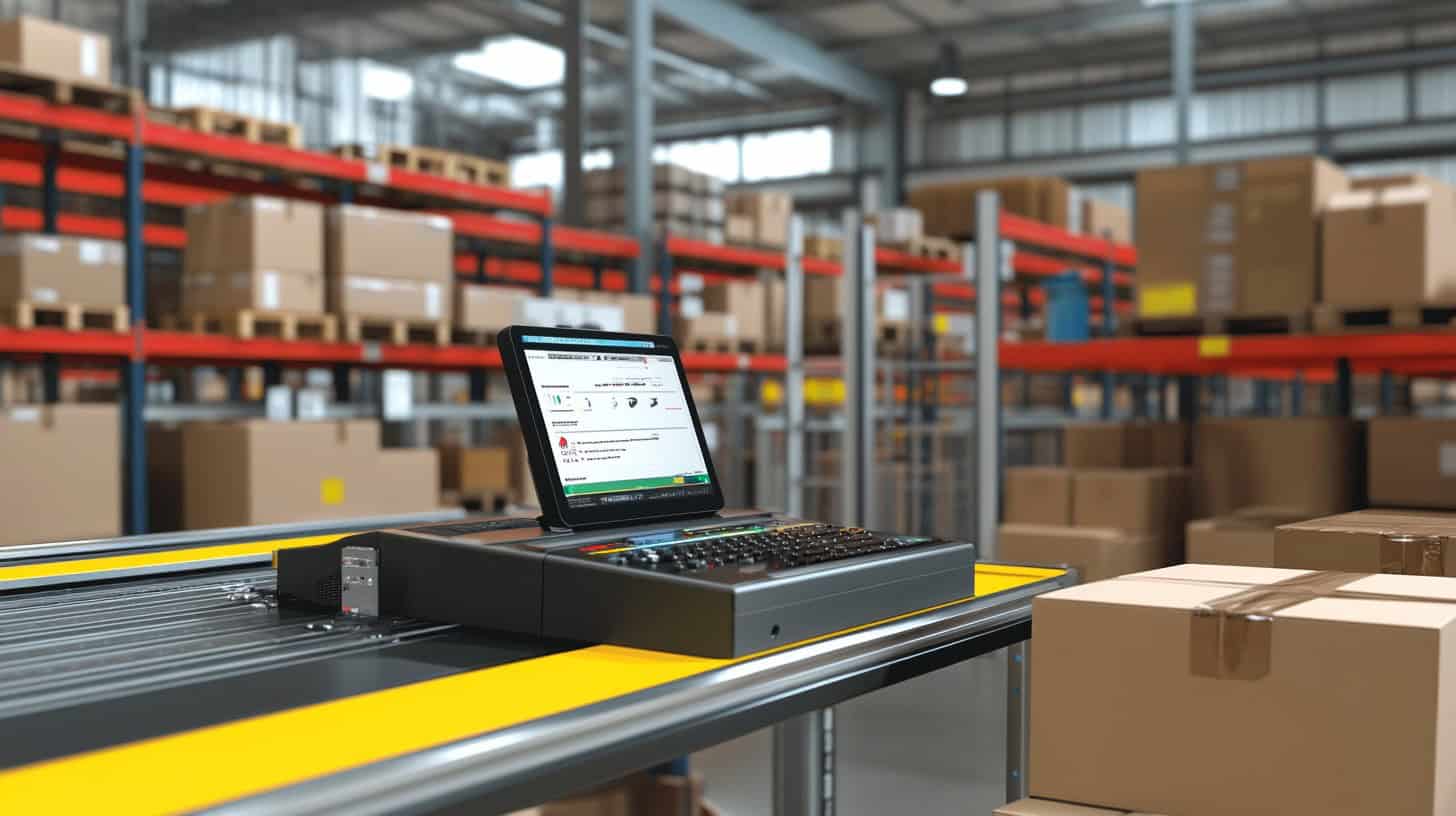Shipping costs eating into your profits? You’re not alone. Small businesses lose up to 25% of their revenue to shipping expenses. 1 But don’t fret! We’ve got your back with 10 genius hacks to slash those costs.
These tips will transform your shipping game. 3 Ready to save big?
Key Takeaways
Small businesses can lose up to 25% of revenue to shipping costs, but smart strategies can slash expenses.
Comparing carriers like USPS (54% market share), UPS (47.7%), and FedEx (37.3%) helps find the best rates and services for your needs.
Optimizing packaging size and materials can prevent damage and reduce dimensional weight charges from carriers.
Shipping software and automation tools boost efficiency, with some users seeing a 16% increase in average order value.
Offering free shipping on orders 30% above your average sale value can increase conversions, as 85% of customers prioritize free shipping.
Table of Contents
Exploring Shipping Costs and Options

Shipping costs can make or break your small biz. It’s time to get smart about your options! Dig into different carriers and compare their speeds and prices – you might be surprised at what you find.
Research various carriers
Picking the right carrier can make or break your shipping game. Let’s dive into how to research carriers and find your perfect match.
- Compare rates: Use multi-carrier calculators to check prices across USPS, UPS, FedEx, and DHL. USPS leads with 54% market share, followed by UPS at 47.7%, and FedEx at 37.3%. 2
- Speed matters: Look at delivery times for each service level. Some offer same-day delivery, while others might take a few days.
- Track record: Check carrier reliability. A reputable carrier like Couriers Atlanta might have better on-time delivery stats than others.
- Special services: See if carriers offer extras like Saturday delivery or signature confirmation. These can be game-changers for your biz.
- Tech tools: Look for carriers with user-friendly websites and shipping software. Good tech can save you tons of time and headaches. 1
- Coverage areas: Make sure your chosen carrier reaches all your customers. DHL, with 5.7% U.S. market share, might be great for international shipping.
- Hidden fees: Watch out for surcharges on fuel, residential delivery, or oversized packages. These can add up fast!
- Customer service: Test each carrier’s support. You’ll want help when things go wrong… and they will, trust me.
- Packaging options: Some carriers offer free boxes or flat-rate options. This can be a huge money-saver for small businesses.
- Pickup services: Check if carriers will grab packages from your location. This can be a real time-saver, especially as you grow.
Compare service speeds and prices
After scoping out carriers, it’s time to dive into the nitty-gritty. Let’s break down service speeds and prices – the real meat and potatoes of shipping decisions. 4
| Carrier | Service | Speed | Price Range | Notes |
|---|---|---|---|---|
| USPS | First Class Mail | 1-3 business days | $ | Best for packages under 16 oz |
| USPS | Priority Mail | 1-3 business days | $$ | Up to $50 insurance included |
| USPS | Priority Mail Express | Overnight to 2 days | $$$ | Up to $100 insurance included |
| UPS | Ground | 1-5 business days | $$ | Flat rate boxes up to 70 lbs |
| FedEx | Ground | 1-5 business days | $$ | One Rate boxes up to 50 lbs |
Pro tip: Mix and match services based on package weight and delivery urgency. USPS First Class Mail is a steal for light packages, while flat rate options from UPS or FedEx can be gold for heavier items. 3 Keep your shipping costs to 15-20% of total revenue to stay in the green. Happy shipping, geeks!
Developing Effective Shipping Strategies

Crafting a killer shipping strategy isn’t rocket science… but it’s close! It’s all about finding that sweet spot between keeping costs low and customers happy. Smart packaging choices can make a world of difference – think outside the box (pun intended) to slash those pesky shipping fees.
Design a comprehensive shipping strategy
Crafting a shipping strategy is tricky, but doable! You’ll need to balance costs, speed, and customer expectations like a pro. Start by checking your current shipping process. Look for slowdowns and money-wasters.
Then, do the math. Compare carriers, service levels, and packaging choices. Keep an eye on those yearly price bumps – USPS, UPS, and FedEx are raising rates by 5.9% in 2024. 5
Now, think about your customers. They hate surprise costs – 75.7% abandon their carts because of hidden shipping fees. Be clear about charges. Maybe offer free shipping with a catch.
Set a minimum order value about 30% above your average order. This can boost sales and keep shipping profitable. Keep in mind, 36% of shoppers leave if shipping costs too much. It’s all about balance! 2
A good shipping strategy is like a well-oiled machine – it keeps your business running smoothly and efficiently.
Optimize packaging for cost reduction
Now that you’ve got a solid shipping strategy, let’s talk about cutting costs on packaging. Smart packaging can save you big bucks! Did you know that in the U.S., $1 billion worth of goods get damaged during shipping each year? Yikes! But don’t worry, we’ve got some tricks up our sleeve.
First off, size matters. Using the right box size can slash your shipping costs. Think about it – why pay for air? UPS and FedEx use a formula (LxWxH / 139) to figure out dimensional weight.
USPS uses a slightly different one (LxWxH / 166). So, pick boxes that snugly fit your products. 6 Also, try lightweight packing materials. Bubble wrap and airbags are your friends here.
They’re light but still keep your stuff safe. And hey, your customers will thank you for not having to dig through a mountain of peanuts to find their order! 7
Utilizing Technology to Enhance Efficiency

Tech can be a game-changer for your shipping game. Smart software and automation tools can slash your workload and boost accuracy – it’s like having a digital assistant on steroids!
Automate shipping processes
Shipping automation is a game-changer for small businesses. It’s like having a robot assistant who never sleeps! With tools like ShipStation, you can zap away tedious tasks. No more manual order entry or label printing – these systems do it all.
They sync with your online store, grab order details, and spit out shipping labels faster than you can say “package delivered.” 8
But wait, there’s more! IoT devices are joining the party. These smart gadgets track your inventory and shipments in real-time. They’re like tiny spies… but for good! They help you optimize routes and cut down on errors. 9 Plus, automated picking and packing machines boost speed and accuracy. It’s like giving your shipping process a turbo boost. ShipStation users even saw a 16% jump in average order value with their Branded Returns Portal.
Now that’s what I call a shipping success story!
Implement shipping software for management
Shipping software is a game-changer for small biz owners. It’s like having a digital shipping guru at your fingertips! This nifty tech helps you track inventory in real-time, monitor shipments, and even crunch numbers to spot areas where you can save some cash. 10 Plus, it’s a breeze to use – no tech wizardry required.
Good software is like a good friend – it’s there when you need it and makes your life easier.
I’ve used these tools myself, and let me tell you, they’re worth their weight in gold. They slash shipping costs, boost profits, and make customers happier. 11 Ship.com, for example, offers sweet deals on shipping rates and free home pickup.
That’s a win-win in my book!
Selecting the Appropriate Shipping Carrier

Picking the right shipping carrier can make or break your small biz. It’s not just about cost – speed, reliability, and customer service matter too. FedEx, UPS, and USPS each have their pros…
so do your homework before committing!
Evaluate factors like reliability, cost, speed
Picking the right shipping carrier can make or break your small business. Let’s dive into the key factors you should weigh when choosing your shipping partner.
- Reliability: Your packages need to arrive on time, every time. Check carrier track records for on-time deliveries and lost package rates. Ask fellow geeks or browse online forums for real-world experiences. 12
- Cost: Shipping fees can eat into profits fast. Compare base rates, surcharges, and volume discounts. Don’t forget to factor in packaging costs too. Some carriers offer free boxes, which can save you a bundle. 11
- Speed: In our instant-gratification world, customers want their stuff yesterday. Look at delivery times for different service levels. Some carriers excel at overnight shipping, while others shine with ground service.
- Coverage area: Make sure your chosen carrier can reach all your customers. This is extra important if you ship internationally or to remote areas.
- Tracking capabilities: Your tech-savvy customers will want real-time package tracking. Check out each carrier’s tracking tools and APIs for integration with your systems.
- Insurance options: Accidents happen. Compare insurance costs and claim processes. Some carriers include basic coverage, while others charge extra.
- Pickup services: If you ship a lot, having packages picked up can save time and hassle. See which carriers offer free pickup and how often.
- Technology integration: Look for carriers with robust APIs and plugins for your e-commerce platform. This can streamline your shipping process and reduce errors.
- Customer service: When things go wrong, you need help fast. Test out each carrier’s customer support channels and response times.
- Special handling: If you ship fragile items or hazardous materials, make sure your carrier can handle them safely and legally.
Review major carriers: USPS, FedEx, DHL
Let’s check out the big three shipping carriers. Each has its own strengths and quirks. Here’s a quick rundown to help you pick the best fit for your small biz: 13
| Carrier | Pros | Cons | Best For |
|---|---|---|---|
| USPS | – Cheapest for packages under 1 lb – Free pickup – Saturday delivery at no extra cost | – Less reliable tracking – Slower for larger packages | Small, light items; budget-conscious shippers |
| FedEx | – Fast delivery times – Excellent tracking – Good for bulky items | – More expensive – Surcharges for residential delivery | Time-sensitive shipments; B2B deliveries |
| DHL | – Global reach – Competitive international rates – Customs expertise | – Limited domestic service in US – Can be pricey for small shipments | International shipping; e-commerce businesses 14 |
Pro tip: Mix and match these carriers. Use USPS for light parcels, FedEx for urgent deliveries, and DHL for global shipments. This combo can slash your shipping costs big time. $100 insurance comes standard with FedEx and UPS. USPS throws in free insurance up to $100 for Priority Mail Express. Smart, eh?
Managing Shipping Volumes

Shipping volumes can make or break your bottom line. Smart businesses know how to play the volume game – it’s all about bundling orders and dangling free shipping carrots.
Consolidate shipping for bulk orders
Bulk orders can be a game-changer for small businesses. By grouping multiple items into one shipment, you’ll slash costs and keep your stuff safer. It’s like hitting two birds with one stone! Plus, you’ll spend less time packing and more time growing your biz.
Smart geeks know that bundling orders is the way to go. 1
But wait, there’s more! Teaming up with fulfillment centers can take your shipping to the next level. These pros handle all the nitty-gritty details, from packing to sending. It’s like having a shipping superhero on your side.
You focus on what you do best, while they make sure your goods reach customers fast and in one piece. It’s a win-win for tech-savvy entrepreneurs looking to scale up. 11
Offer free shipping on minimum order conditions
Free shipping is a game-changer for online shops. It’s like catnip for customers – they can’t resist it! In fact, 85% of folks say it’s a top priority when buying stuff online. 15 But here’s the trick: set a minimum order value about 30% higher than your average sale.
This way, you’re not losing money on every package.
Free shipping isn’t just a perk – it’s the secret sauce of e-commerce success.
Smart sellers use this tactic to boost sales. They show items that help hit the free shipping mark right on the checkout page. It’s a win-win – customers get a deal, and you sell more.
Plus, you’re in good company. Over 95% of online stores offer some kind of free shipping at checkout. 11 It’s not just a trend – it’s the new normal in e-commerce.
Mastering International Shipping

Ready to go global? Shipping across borders can be tricky… but it’s not rocket science! With the right know-how, you’ll be zipping packages worldwide like a pro in no time.
Learn about customs regulations and fees
Customs rules can be tricky. Each country has its own set of laws for goods coming in. You’ll need to know these rules to avoid delays or fines. Fees can also add up fast. There’s import duty, value-added tax, and sometimes extra charges.
It’s smart to check with the Customs and Border Protection (CBP) for the latest info. 1
Don’t forget about paperwork! You’ll need the right forms filled out correctly. This might include a commercial invoice, packing list, and certificate of origin. Getting these wrong can hold up your shipment big time.
Pro tip: some countries have special rules for certain items. Do your homework before you ship anything unusual or valuable. 16
Select carriers with robust international networks
Picking the right carrier for global shipping can make or break your business. DHL Express is great for small shops getting into international trade. They have a massive network across the globe, which means quicker deliveries and fewer issues along the way.
Their technology is excellent, too, so you can track packages easily. 2
But it’s smart to work with multiple carriers. This approach speeds up delivery times and reduces risks. You’ll also have more leverage when negotiating prices. Here’s a tip: Build relationships with carrier account managers.
They might offer you great discounts and benefits you weren’t aware of. 17
Focusing on Packaging and Branding

Your packaging speaks volumes about your brand. It’s your chance to wow customers and leave a lasting impression – so don’t skimp on it! Think outside the box (pun intended) and get creative with your packaging design.
Brand packaging for improved customer experiences
Geeks, listen up! Brand packaging isn’t just a box. It’s your chance to wow customers. Think of it as your product’s superhero costume. Cool packaging makes people excited to open their order.
It’s like Christmas morning, but for your brand! 18
Here’s the deal: good packaging keeps your stuff safe and looks awesome. It’s a win-win. Customers love it when their order arrives in one piece and looks great. Plus, it makes them want to buy from you again.
And hey, if your packaging rocks, they might even show it off online. Free marketing, anyone? 19 Next up, let’s talk about making returns a breeze.
Ensure packaging safety to reduce damages
Moving from brand packaging to safety, let’s talk about protecting your goods. Safe packaging is key to happy customers and fewer losses. Did you know? Each year, U.S. businesses lose $1 billion due to shipping damage.
Yikes! That’s a lot of cash down the drain. 7
So, how do we fix this? First, cut down on empty space in boxes. It’s not just about saving on packing materials. Less wiggle room means less chance for items to bounce around and break. 20 Next, train your team on proper packing techniques. It’s like teaching a secret handshake – but way more useful. With these tricks up your sleeve, you’ll see fewer broken items and more smiling faces when packages arrive.
Streamlining Returns and Refunds

Returns can be a real headache for small businesses. But with a smart plan, you can turn them into a chance to wow your customers and keep ’em coming back.
Establish a clear return policy
A clear return policy is a must for your gaming business. It builds trust and keeps customers coming back. Put it front and center on your website – don’t hide it! 21 A 30-day window is common and gives folks time to check out their purchases.
Some shops even offer free returns, which can really boost loyalty.
Make your policy easy to understand. No complicated terms or legal jargon. Just spell out what can be returned, how to do it, and any costs involved. 22 This clarity helps avoid confusion and keeps both you and your customers happy.
A good return policy isn’t just about rules – it’s about showing you care about your customers’ satisfaction.
Simplify the customer return process
Returns can make or break a small business. Let’s dive into ways to simplify the process and keep your geek customers happy.
- Clear policy: Spell out your return rules in plain English. No legalese or fine print. 24
- Easy-to-find info: Put return details on your site’s main menu and product pages.
- Prepaid labels: Include return labels in packages. It’s a small cost that pays off big. 23
- Extended windows: Give customers 30-60 days to return items. More time equals less stress.
- Free returns: If possible, offer free return shipping. It can boost sales by 20%.
- Multiple options: Let folks return by mail or in-store. Flexibility is key.
- Quick refunds: Process refunds ASAP. Aim for 3-5 business days max.
- No-questions-asked policy: Skip the 20 questions. Trust your customers.
- Email updates: Send tracking info for returns. Keep folks in the loop.
- Gift returns: Make it easy to return gifts without receipts. Your customers will thank you.
Now that we’ve tackled returns, let’s look at how to brand your packaging for a wow factor.
Enhancing Shipping Practices Continuously

Shipping’s always changing, so you gotta keep up! Track your data and listen to what customers say. It’ll help you stay on top of your game and save some serious cash.
Track and analyze shipping data
Shipping data is a goldmine for smart business owners. By keeping an eye on your shipments, you can spot trends and save big bucks. Got a bunch of packages going to the same zip code? You might snag a sweet discount by bundling them together.
Or maybe you’ll notice that certain products always arrive late – time to switch carriers! It’s like being a detective, but instead of solving crimes, you’re figuring out efficient shipping. 25
Numbers don’t lie, and neither does your shipping data. Use tools like Google Analytics to track your packages from start to finish. You’ll see which routes are fastest, which carriers are most reliable, and where your costs are increasing.
With this info, you can make smart choices that’ll keep your customers happy and your wallet full. In e-commerce, knowledge is power – and shipping data is your secret weapon. 26
Modify strategies based on customer feedback and cost adjustments
After crunching the numbers, it’s time to fine-tune your game plan. Smart geeks know that shipping isn’t set-and-forget. You gotta keep your ear to the ground and your eyes on the prize.
Listen to what your customers are saying – they’re the real MVPs here. Are they griping about slow delivery? Time to kick things up a notch. Maybe they’re raving about your eco-friendly packaging? Double down on that green goodness.
But don’t just stop at customer chatter. Keep tabs on those pesky costs too. Carriers love to shake things up with new fees or rate hikes. Stay sharp and pivot when needed. If FedEx is bleeding you dry, maybe it’s time to give USPS a shot.
Or hey, why not mix it up with a regional carrier for those nearby deliveries? The key is to stay nimble. Tweak, test, and repeat. Your perfect shipping strategy is out there – you just gotta keep tinkering until you nail it. 27 3
People Also Ask
How can small businesses cut shipping costs?
Small businesses can save big on shipping by using third-party logistics providers, exploring dropshipping options, or trying Fulfillment by Amazon (FBA). These methods can trim expenses and boost profitability.
What are some eco-friendly packaging options for online retailers?
Eco-conscious e-commerce businesses can opt for sustainable packaging like recyclable boxes, reusable airbags, or biodegradable tissue paper. This approach pleases customers and helps Mother Nature.
Is it better to handle shipping in-house or outsource it?
The choice between in-house and outsourced shipping depends on your business size and needs. Outsourcing to a 3PL can save time and money for some, while others prefer the control of in-house operations.
How can I offer same-day deliveries without breaking the bank?
To provide speedy service without emptying your wallet, partner with local courier services or use USPS Priority Mail. You could also team up with nearby retail shops for customer pickup options.
What’s the deal with shipping insurance? Is it worth it?
Shipping insurance can be a lifesaver for valuable cargo. Third-party insurance often costs less than carrier services. It’s a small price to pay for peace of mind and customer satisfaction.
How can I make my online store’s shipping more competitive?
To stand out in the crowded e-commerce world, consider offering free shipping thresholds, flat-rate options, or even a shipping subscription service. Don’t forget to clearly display your shipping policies to avoid cart abandonment.
References
^ https://sellercloud.com/blog/top-20-practical-shipping-tips-for-small-businesses/
^ https://shipware.com/blog/10-shipping-tips-for-small-businesses-to-save-you-money/ (2021-02-22)
^ https://www.shopify.com/blog/competitive-shipping-as-a-small-shop (2024-06-20)
^ https://www.easyship.com/blog/small-business-shipping-guide (2024-01-30)
^ https://www.easyship.com/blog/how-to-create-a-shipping-strategy (2021-07-29)
^ https://dclcorp.com/blog/shipping/cost-effective-packaging/
^ https://warespace.com/articles/shipping-and-packaging-insights/optimize-shipping-reduce-packaging-costs
^ https://www.veeqo.com/blog/automate-shipping-process (2023-04-27)
^ https://warespace.com/articles/shipping-and-packaging-insights/shipping-packaging-automation
^ https://www.ship.com/post/how-shipping-management-software-can-revolutionize-your-logistics
^ https://www.routific.com/blog/small-business-shipping-tips (2024-03-18)
^ https://www.citrusfreight.com/resource/blog/choosing-shipping-carrier (2024-03-19)
^ https://www.shipbob.com/ecommerce-shipping/carriers/
^ https://www.packiyo.com/blog/shipping-carrier (2024-07-16)
^ https://www.uspsdelivers.com/implementing-free-shipping-through-minimum-order-value/
^ https://wareiq.com/resources/blogs/international-shipping/ (2024-06-10)
^ https://www.sendcloud.com/carrier-selection-tips-for-international-shipping/ (2024-07-30)
^ https://thegood.com/insights/custom-packaging-brand-experience/
^ https://shawngraham.me/blog/using-product-packaging-to-create-amazing-customer-experiences
^ https://disk.com/resources/packaging-strategies-to-minimize-product-damage-during-shipping/
^ https://www.theupsstore.com/small-business-services/small-business-blog/small-business-blog/2023/11/small-business-return-policy (2023-11-13)
^ https://pay.com/blog/return-policy-for-small-businesses
^ https://www.linkedin.com/pulse/simplify-your-returns-process-boost-customer-satisfaction-sgfqc
^ https://corp.narvar.com/blog/simplify-the-returns-process (2023-06-29)
^ https://pay.com/blog/shipping-tips-for-small-businesses
^ https://www.freightclub.com/blog/6-tips-small-business-shipping
^ https://fareye.com/resources/blogs/how-to-reduce-shipping-costs



